-
 Bitcoin
Bitcoin $106,754.6083
1.33% -
 Ethereum
Ethereum $2,625.8249
3.80% -
 Tether USDt
Tether USDt $1.0001
-0.03% -
 XRP
XRP $2.1891
1.67% -
 BNB
BNB $654.5220
0.66% -
 Solana
Solana $156.9428
7.28% -
 USDC
USDC $0.9998
0.00% -
 Dogecoin
Dogecoin $0.1780
1.14% -
 TRON
TRON $0.2706
-0.16% -
 Cardano
Cardano $0.6470
2.77% -
 Hyperliquid
Hyperliquid $44.6467
10.24% -
 Sui
Sui $3.1128
3.86% -
 Bitcoin Cash
Bitcoin Cash $455.7646
3.00% -
 Chainlink
Chainlink $13.6858
4.08% -
 UNUS SED LEO
UNUS SED LEO $9.2682
0.21% -
 Avalanche
Avalanche $19.7433
3.79% -
 Stellar
Stellar $0.2616
1.64% -
 Toncoin
Toncoin $3.0222
2.19% -
 Shiba Inu
Shiba Inu $0.0...01220
1.49% -
 Hedera
Hedera $0.1580
2.75% -
 Litecoin
Litecoin $87.4964
2.29% -
 Polkadot
Polkadot $3.8958
3.05% -
 Ethena USDe
Ethena USDe $1.0000
-0.04% -
 Monero
Monero $317.2263
0.26% -
 Bitget Token
Bitget Token $4.5985
1.68% -
 Dai
Dai $0.9999
0.00% -
 Pepe
Pepe $0.0...01140
2.44% -
 Uniswap
Uniswap $7.6065
5.29% -
 Pi
Pi $0.6042
-2.00% -
 Aave
Aave $289.6343
6.02%
Must I sell when the Momentum Index (MTM) crosses the moving average?
The Momentum Index (MTM) measures price velocity and, when combined with a moving average, can signal shifts in crypto trends, though traders should avoid impulsive decisions and instead use additional tools like volume and candlestick patterns for confirmation.
Jun 15, 2025 at 10:56 am
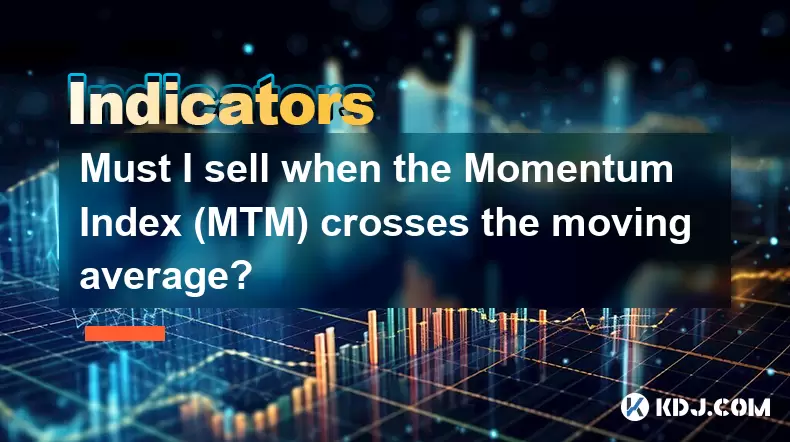
Understanding the Momentum Index (MTM)
The Momentum Index (MTM) is a technical analysis tool used to measure the speed or velocity of price changes in a cryptocurrency. It calculates the difference between the current closing price and the closing price from a specific number of periods ago. Traders often use this indicator to identify overbought or oversold conditions, as well as potential trend reversals.
When the MTM line crosses above zero, it indicates that the price is rising faster than before, suggesting bullish momentum. Conversely, when it dips below zero, it signals bearish momentum. However, simply observing the direction of the MTM line isn't always sufficient for making trading decisions, especially when combined with other indicators like moving averages.
What Happens When MTM Crosses the Moving Average?
A common strategy among traders involves using a moving average (MA) alongside the MTM indicator. The moving average smooths out price data over time, helping filter out market noise. When the MTM crosses its moving average—typically a 9-period or 20-period MA—it can signal a shift in momentum.
For example, if the MTM crosses above its moving average, it may suggest increasing upward momentum, which could be interpreted as a buy signal. On the flip side, a cross below the moving average might indicate weakening momentum and a potential sell-off. However, these signals are not foolproof and should be analyzed within the broader context of market conditions.
Why Selling Isn’t Always Necessary on a MTM-MA Crossover
There is no one-size-fits-all rule in trading. Just because the MTM crosses below the moving average, it doesn't necessarily mean you must sell immediately. Several factors can influence the reliability of this crossover:
- Market Trend: In strong uptrends, MTM often fluctuates around the moving average without confirming a reversal.
- Timeframe: Short-term crossovers may produce false signals, while longer timeframes tend to offer more reliable readings.
- Volume Confirmation: A drop in volume during a crossover may indicate weak selling pressure, reducing the likelihood of a sustained downtrend.
- Other Indicators: Relying solely on MTM and moving averages can lead to premature exits. Combining tools like RSI or MACD may provide better confirmation.
Therefore, traders should avoid impulsive decisions based solely on MTM and moving average interactions.
How to Use MTM and Moving Averages Together Effectively
To make informed decisions using MTM and moving averages, follow these steps:
- Choose Appropriate Period Settings: Most platforms default to a 14-period MTM and a 9-period MA, but adjust based on your trading style and asset volatility.
- Plot Both Indicators on the Chart: Ensure both the MTM oscillator and its moving average are visible on the same sub-chart for easier comparison.
- Watch for Divergences: If the price makes a new high but the MTM fails to do so, it may signal an impending reversal—even without a crossover.
- Set Alerts: Use trading platforms to set alerts for when MTM crosses its moving average, allowing timely review of the situation.
- Combine with Candlestick Patterns: Look for engulfing candles or doji patterns near crossover points to strengthen decision-making.
By integrating multiple analytical methods, traders can reduce false signals and improve the accuracy of their trades.
Backtesting Your MTM-Moving Average Strategy
Before applying any strategy live, it’s essential to backtest it across various market cycles. Here's how to conduct a basic backtest:
- Select Historical Data: Choose at least one full bull and bear cycle of the cryptocurrency you're analyzing.
- Apply the Indicator Setup: Configure MTM and its moving average exactly as you would in real-time trading.
- Mark Entry and Exit Points: Identify where crossovers occurred and whether they led to profitable trades.
- Calculate Win/Loss Ratio: Determine how often the strategy produced winning trades versus losing ones.
- Adjust Parameters: Experiment with different MTM and MA settings to see if performance improves.
Backtesting helps validate whether relying on MTM crossing the moving average has historically been a useful trigger for buying or selling.
Frequently Asked Questions
Q: Can I rely solely on MTM and moving average for trading crypto?
No, it's generally unwise to depend solely on any single indicator combination. Cryptocurrency markets are highly volatile and influenced by external factors such as news events, regulatory updates, and macroeconomic trends. Always cross-reference with other tools and fundamental insights.
Q: What timeframes work best for MTM and moving average strategies?
Shorter timeframes like 5-minute or 15-minute charts generate more frequent signals but also more noise. Daily or weekly charts tend to provide clearer, albeit less frequent, signals. Day traders may prefer shorter intervals, while swing traders might focus on higher timeframes.
Q: How do I know if a MTM crossover is a false signal?
False signals often occur in ranging or sideways markets. You can verify them by checking for lack of volume support, absence of candlestick confirmation, or divergence with other momentum indicators like RSI or MACD.
Q: Should I use exponential or simple moving averages with MTM?
Exponential moving averages (EMA) react faster to recent price changes and are preferred by many traders for quicker responses. Simple moving averages (SMA) offer smoother lines but lag more. Test both to see which aligns better with your trading goals.
Disclaimer:info@kdj.com
The information provided is not trading advice. kdj.com does not assume any responsibility for any investments made based on the information provided in this article. Cryptocurrencies are highly volatile and it is highly recommended that you invest with caution after thorough research!
If you believe that the content used on this website infringes your copyright, please contact us immediately (info@kdj.com) and we will delete it promptly.
- 2025-W Uncirculated American Gold Eagle and Dr. Vera Rubin Quarter Mark New Products
- 2025-06-13 06:25:13
- Ruvi AI (RVU) Leverages Blockchain and Artificial Intelligence to Disrupt Marketing, Entertainment, and Finance
- 2025-06-13 07:05:12
- H100 Group AB Raises 101 Million SEK (Approximately $10.6 Million) to Bolster Bitcoin Reserves
- 2025-06-13 06:25:13
- Galaxy Digital CEO Mike Novogratz Says Bitcoin Will Replace Gold and Go to $1,000,000
- 2025-06-13 06:45:13
- Trust Wallet Token (TWT) Price Drops 5.7% as RWA Integration Plans Ignite Excitement
- 2025-06-13 06:45:13
- Ethereum (ETH) Is in the Second Phase of a Three-Stage Market Cycle
- 2025-06-13 07:25:13
Related knowledge

How to confirm the effectiveness of the average price line support in the time-sharing chart?
Jun 17,2025 at 12:56am
Understanding the Time-Sharing Chart and Its RelevanceIn cryptocurrency trading, time-sharing charts play a crucial role in analyzing short-term price movements. These charts typically display price fluctuations over a specific period, often ranging from minutes to hours. Traders rely on them to make quick decisions based on real-time data. The average ...

What does it mean when the momentum indicator breaks above the zero axis?
Jun 17,2025 at 12:43am
Understanding the Momentum IndicatorThe momentum indicator is a technical analysis tool used to measure the speed or velocity of price movements in cryptocurrency markets. It helps traders identify potential trend reversals, overbought or oversold conditions, and confirms existing trends. The indicator typically oscillates around a zero line, with value...
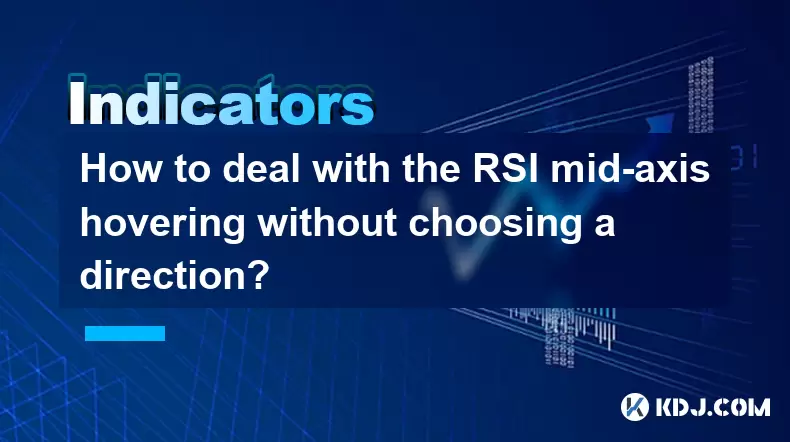
How to deal with the RSI mid-axis hovering without choosing a direction?
Jun 17,2025 at 02:02am
Understanding RSI Mid-Axis Hovering in Cryptocurrency TradingThe Relative Strength Index (RSI) is a popular momentum oscillator used by traders to assess whether an asset is overbought or oversold. In cryptocurrency markets, it's common for the RSI to hover around its mid-axis, typically at the 50 level, without showing a clear upward or downward trend....
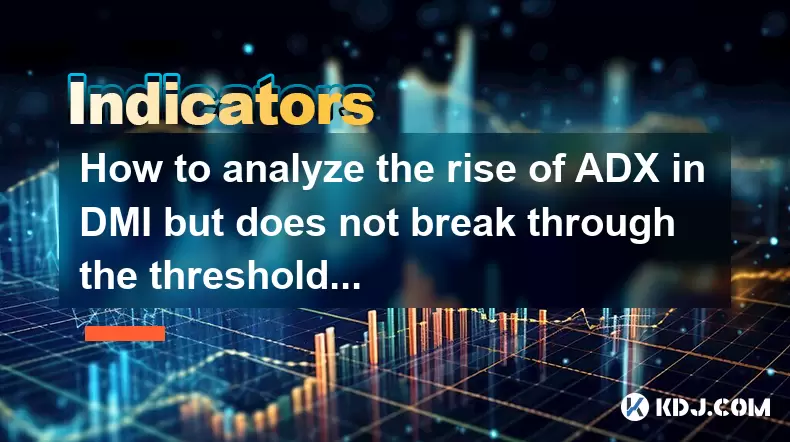
How to analyze the rise of ADX in DMI but does not break through the threshold?
Jun 16,2025 at 11:49pm
Understanding ADX and DMI in Cryptocurrency TradingIn cryptocurrency trading, ADX (Average Directional Index) is a technical indicator used to measure the strength of a trend. It works in conjunction with the DMI (Directional Movement Indicator), which includes two components: +DI (Positive Directional Indicator) and -DI (Negative Directional Indicator)...
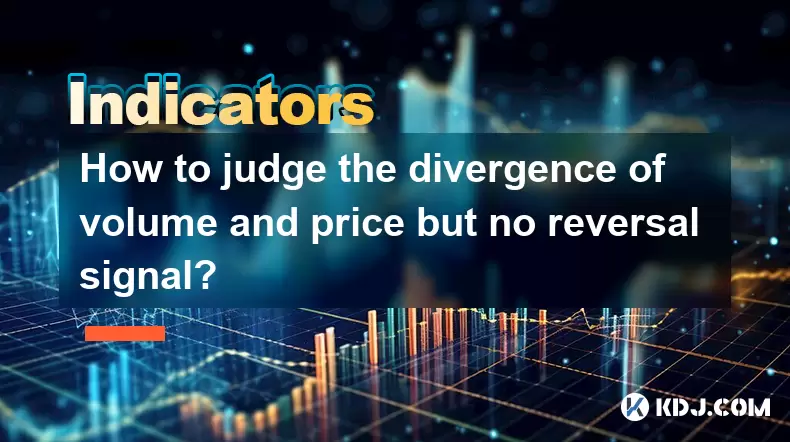
How to judge the divergence of volume and price but no reversal signal?
Jun 17,2025 at 12:28am
Understanding Volume and Price DivergenceIn the world of cryptocurrency trading, volume and price are two key indicators that traders monitor closely. Divergence occurs when these two metrics move in opposite directions. For example, if the price of a cryptocurrency is rising but its volume is declining, this could signal weakening momentum. However, it...
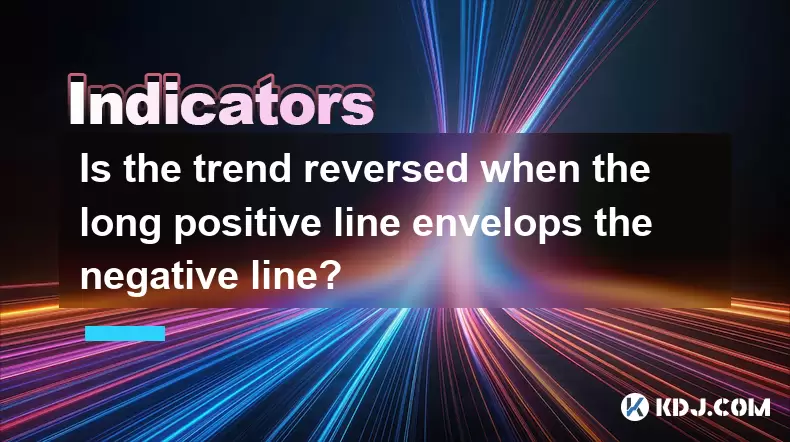
Is the trend reversed when the long positive line envelops the negative line?
Jun 17,2025 at 03:28am
Understanding the Envelope Pattern in Candlestick ChartsIn candlestick charting, one of the most widely recognized reversal patterns is the 'enveloping pattern.' This pattern typically appears at the end of a trend and signals a potential reversal. When a long positive (bullish) candle completely engulfs the previous negative (bearish) candle, it can in...

How to confirm the effectiveness of the average price line support in the time-sharing chart?
Jun 17,2025 at 12:56am
Understanding the Time-Sharing Chart and Its RelevanceIn cryptocurrency trading, time-sharing charts play a crucial role in analyzing short-term price movements. These charts typically display price fluctuations over a specific period, often ranging from minutes to hours. Traders rely on them to make quick decisions based on real-time data. The average ...

What does it mean when the momentum indicator breaks above the zero axis?
Jun 17,2025 at 12:43am
Understanding the Momentum IndicatorThe momentum indicator is a technical analysis tool used to measure the speed or velocity of price movements in cryptocurrency markets. It helps traders identify potential trend reversals, overbought or oversold conditions, and confirms existing trends. The indicator typically oscillates around a zero line, with value...

How to deal with the RSI mid-axis hovering without choosing a direction?
Jun 17,2025 at 02:02am
Understanding RSI Mid-Axis Hovering in Cryptocurrency TradingThe Relative Strength Index (RSI) is a popular momentum oscillator used by traders to assess whether an asset is overbought or oversold. In cryptocurrency markets, it's common for the RSI to hover around its mid-axis, typically at the 50 level, without showing a clear upward or downward trend....

How to analyze the rise of ADX in DMI but does not break through the threshold?
Jun 16,2025 at 11:49pm
Understanding ADX and DMI in Cryptocurrency TradingIn cryptocurrency trading, ADX (Average Directional Index) is a technical indicator used to measure the strength of a trend. It works in conjunction with the DMI (Directional Movement Indicator), which includes two components: +DI (Positive Directional Indicator) and -DI (Negative Directional Indicator)...

How to judge the divergence of volume and price but no reversal signal?
Jun 17,2025 at 12:28am
Understanding Volume and Price DivergenceIn the world of cryptocurrency trading, volume and price are two key indicators that traders monitor closely. Divergence occurs when these two metrics move in opposite directions. For example, if the price of a cryptocurrency is rising but its volume is declining, this could signal weakening momentum. However, it...

Is the trend reversed when the long positive line envelops the negative line?
Jun 17,2025 at 03:28am
Understanding the Envelope Pattern in Candlestick ChartsIn candlestick charting, one of the most widely recognized reversal patterns is the 'enveloping pattern.' This pattern typically appears at the end of a trend and signals a potential reversal. When a long positive (bullish) candle completely engulfs the previous negative (bearish) candle, it can in...
See all articles

























































































